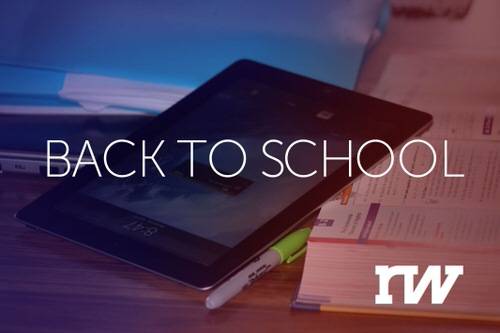
This is a post in Back To School, an ongoing series where ReadWrite covers technology trends in education for parents and educators.
In many communities around the North America, parents and students are beginning the annual rite of passage of preparing for school. As early as this week, school buses will be rolling, and parents are getting their kids ready to go.
In the days of yore, preparations would have entailed buying folders, paper and pencils. Today, the expectation for parents who want to give their kids every advantage is to load them up with as much technology as possible, especially at the elementary-school level.
From one perspective, this makes sense: get your kids started early and they will be masters of the online universe by the time they hit high school. But this is an area where parents can easily go overboard and weigh their little student down with a lot of expensive technology they don’t need and won’t be much help.
Set Goals First
When thinking about technology, the important thing to remember is: Take into account the learning goals for the child as well as the current technology policies of your student’s school.
Unfortunately, elementary schools around the country vary wildly in their use of technology. Some lucky public and private schools have the funding and training to deliver individual devices to every student in their classrooms—even, in some cases, being able to take them home. But, in more cases than not, computers are sparse, and shared between students in special lab classrooms.
There is also the question of technology type: Thanks to a very aggressive marketing strategy, Apple is a very dominant presence in schools today. If this is the case in your school district, then you might be tempted to buy similar technology for home use. That’s definitely what Apple wants you to do. But hold on before you head to the Apple Store; check with the teacher and find out if the students are using native installed apps or cloud-based services that just run over the Web. Cloud learning tools are beginning to be more common since they are easier to configure and license across an entire school. If there is a cloud service being used, you can probably run that service on any Internet-connected computing device.
This is why it is critical to communicate with your child’s school and find out what they have going on now and planned for the near future. You will want to balance their approach with what you do at home and not plunk too much money down for something you don’t need.
Getting The Hardware
There are two questions I get from parents of elementary-age students about technology: What kind of computer should I get and what kind of smartphone? The second question, at this stage of students’ education career, is easier to answer, so it will be addressed first.

Except in very rare instances, don’t buy your kid a smartphone in elementary school. In fact, don’t buy your student a cell phone, period.
I realize that this might run counter to the parents who have heard their childrens’ pleas for the latest iPhone and are starting to succumb to the begging. Resist, for one simple reason: They don’t need it. If your child is young, then chances are they will be under adult supervision most of the day and playing with their friends for the rest. Communication is not a big issue in these situations. Texting (and social media participation) is not a requirement, either, and it will be just one more distraction in a home that’s already going to be pretty distracted.
In our home, none of my daughters got a phone at all until they reached one critical juncture: They started staying after school for sport or extracurricular activities. At that point, when school staff leaves for the day and phones get scarce, it was important to their mother and I that they had some way to get a hold of us if a practice or meeting when ran long or short. Or was cancelled at the last minute and the bus was missed.
Your situation will vary, of course, and there are many families who will need their child to have a phone with them at all times. I was a latchkey kid growing up, and if cellphones had been around, I am sure I would have had one. If that is your situation, you should still resist the urge to get a smartphone and pick up a decent feature phone instead.
When it comes to computing devices, the approach is a little more complicated, because needs can vary greatly between students and classrooms. But for elementary-age students, I tend to lean towards recommending tablets for purchase instead of desktop PCs or laptops.
The reasoning is two-fold: First, from K-4, most classrooms are not going to require a lot of output in the curriculum. There are the occasional science projects and book reports, but for the most part, your student is going to need a computing device more for exploration and research than actual production of documents. (Though that’s another thing to check with the school.)
Secondly, a tablet can serve a dual role: When not used as a learning tool, it can be used as an entertainment and communication device. For younger kids, tablets are much more flexible than laptops in this regard.
The kind of tablet you get will depend on the school. If the school is heavily invested in Apple (OS X or iOS) products, then you should probably steer in that direction. However, if the school is using Web-based applications and services (or, sadly, has no strong technology plan at all), then you would be wiser to try an Android-based tablet, such as a Nexus 7 or an Amazon Kindle Fire. In terms of Web use and entertainment content, these tablets are just as good as the iPad, and less expensive to boot.
Online Resources
Your school should have a number of resources of which you can avail yourself for your student’s technology-based learning. Even if it does, here are some recommended sites to try for elementary students’ basic skills.
- PBSKids.org Reading Games: PBS Kids is one of the most outstanding English-based educational sites on the Internet, full of games and video content that’s specifically aimed at teaching kids about many subjects. The Reading Games section is no exception, and should keep beginning readers busy and engaged for good while.
- Jumpstart Reading Games: Educational software maker has helped kids learn to read for a long time with their PC applications, and their online offerings are just as effective.
- IXL: Grade-level practice problems abound on this simple-to-use site, more than enough to give kids the help they need at their own pace.
- Typing Web: This is a skill set where I am biased, but getting your kids typing fast and using the touch method is a really good idea. Mobile or stationary, we’re going to be using QWERTY keyboard interfaces for a long time.
There are far more resources, of course, including some for parents: The North Dakota Department of Public Instruction has an excellent roundup page of educational sites, as does the New York City Department of Education.
Plan ahead for your child’s needs and a year or two down the line, and you should find a good fit for their technology use.
How are you preparing your kids? Share your back-to-school plans in the comments.
Lead image courtesy flickingerbrad via Compfightcc. Computer lab image courtesy World Bank Photo Collection via Compfightcc.










